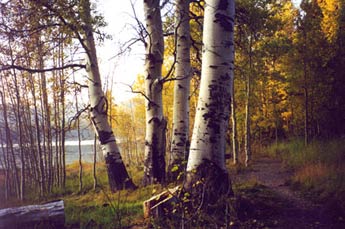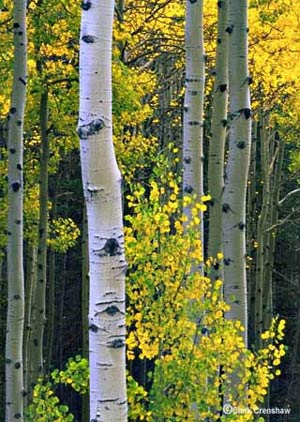Aspen Trees |
||||
| Description: Often called AGolden, Trembling, or Quaking Aspen, this tree is the most widely distributed native tree in North America. The name refers to the leaves, which tremble in the slightest breeze. It is common in the higher mountains of the western two-thirds of New Mexico. | ||||
| Aspens pioneer on burned areas and serve as a nurse crop to conifers that eventually replace them. They spread readily from suckers and root sprouts; and, in fact, a grove of aspens in Utah is the largest known living organism on Earth, covering thousands of acres. Aspen stands are preferred cover for deer and elk and contribute feed to these animals and also to squirrels, rabbits, beaver, and other mammals. | ||||
Leaves: Broad, nearly round, leaves with pointed apex, and finely serrated edges, which are attached to the limbs with a flattened petiole or stem. Leaves are shiny green above, dull green beneath, and turn a spectacular golden yellow in the fall. |
||||
Fruit: One-quarter inch long; narrowly conical, light green capsules in drooping catkins (capsules). In midsummer, these seed capsules burst open and release extremely light, cottony seeds that are easily wind-borne. However, these are rarely produced in the West, where propagation is primarily by root sprouts. |
||||
|
||||
Hardiness Zones: Grows in Rocky Mountains south to New Mexico, 6,500’ to 10,000’. (Zones 3-7, but only where summers are not too hot, and usually requires sharply cold winters to grow best.) |
||||
Height: 40 feet to 70 feet, but rarely taller than 50 feet, and seldom more than 20 inches in diameter. |
||||
Aspens tend to grow in pure stands as a result of this clonal reproductive strategy. This makes them visually cohesive in the landscape, and also provides particular habitat that make them an important tree ecologically (discussed in Natural History). |
||||
Combined with their ability to exploit rare opportunities for sexual reproduction, this two-pronged reproductive strategy has enabled aspen to maintain a broad range spatially and temporally (Mitton and Grant 1996) (see Distribution). |
||||
|

